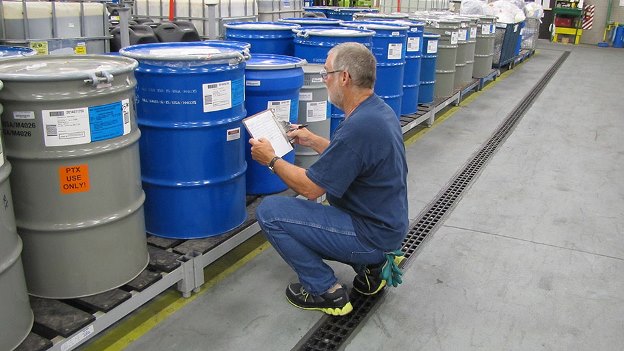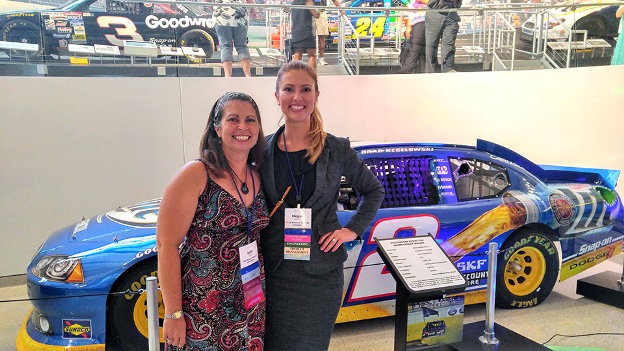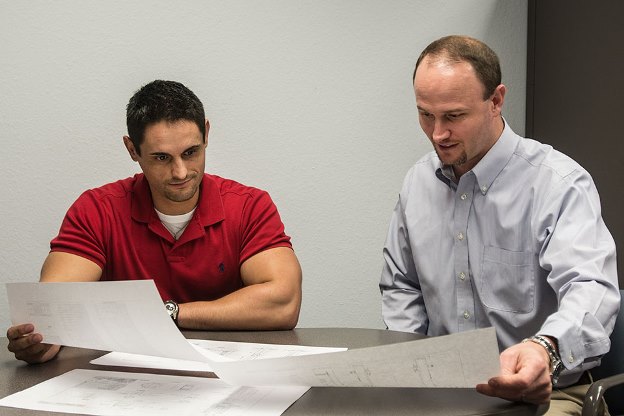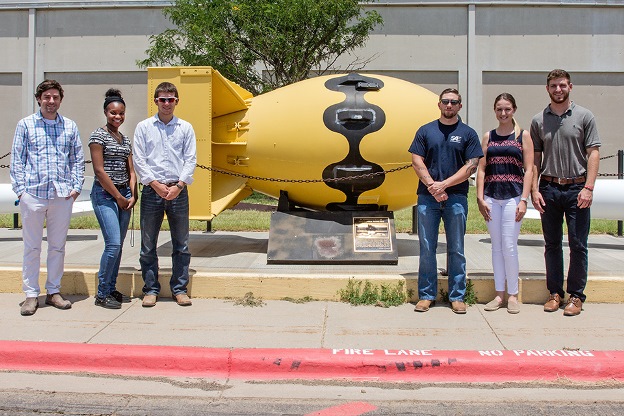Pantex Blog
Pantex and Y-12 receive impressive environmental reviews
Recently, Pantex and Y-12 were inspected by the Environmental Protection Agency. Y-12’s inspection also included a visit from the Tennessee Department of Environment and Conservation. Both sites came away with stellar reviews after three day inspections in areas such as hazardous waste management, training and compliance documentation.

Pantex Waste Operations Engineering Technician John McMahan is one of many employees who works daily to ensure CNS meets environmental standards.
“This is a significant accomplishment that does not happen by accident, but instead through hard work, diligence, and a commitment to excellence,” said Teresa Robbins, NNSA Production Office deputy manager.
In addition to inspecting waste storage areas, the inspectors looked at numerous records. These records included hazardous waste manifests, annual hazardous waste activity reports, waste reduction reports, and hazardous waste training and lesson plan content. Despite the volume of records reviewed, inspectors noted only one minor issue.
Inspectors at each site had positive things to say about the various processes and procedures that they had observed. Inspectors noted that the Material Evaluation Process (waste characterization) employed at Pantex far exceeds what is required by regulation and is better than what he encountered at commercial waste treatment, storage, and disposal facilities. At Y-12, the inspector even asked for a photo of an exceptionally good Y 12 practice to use as a benchmark for others.
“There are hundreds of folks doing the hard work every day and likely wonder if anyone will notice. Each one needs to know that excellence is a choice. And, the string of individual decisions they have made is having a positive impact on this site’s overall reputation,” said Bill Tindal, Y-12 site manager.
“Seeing that there were no violations or concerns identified during this on site inspection only proves that we have a great group of people here that really take pride in their jobs and processes,” said Todd Ailes, Pantex site manager.
A smokin' good time
There was plenty of smoke and fire, but the Pantex firefighters weren’t responding to a four-alarm fire. They were cooking for the annual Amarillo Chamber of Commerce’s Good Times Celebration Barbeque Cook-Off. The Pantex team went up against 99 cook teams, smoking ribs, brisket and other meats, to see who had the best barbeque in town.

Scott Johnson, Pantex battalion fire chief (left) and Saxon Webster, firefighter/EMT, prepare ribs during the Amarillo Chamber of Commerce’s Good Times Celebration Barbeque Cook-Off. For the past 17 years, Pantex firefighters come together in September to smoke the best meats and enjoy the competition. (Photo courtesy of Michael Schumacher, Amarillo Globe-News)
The Good Times Celebration is in its 21st year, and for the past 17 years, Pantex firefighters come together for a couple of days in September to smoke the best meats and enjoy the competition. This year’s event took place Sept. 7 and 8. For some, it’s the group of co-workers that brings them to the barbeque.
“This is my first time to cook for the Chamber event, but I wanted to because of the guys out here on the cook team,” said Jeremy Baker, Pantex firefighter/paramedic. “I cook with them at the Boots vs. Badges event, and we have a great time each year.”
Not only were the Pantex firefighters serving up their best fixings to the judges, they were serving more than 6,000 people who lined the streets of downtown Amarillo for the event.
“When you watch a person bite into a rib, slice of brisket or a piece chicken and you get the eye roll along with the ‘yum’ sound effect, you feel good knowing what you worked at for hours has paid off,” said Scott Johnson, Pantex battalion fire chief.
Even though the team did not place in this year’s event, they are tweaking their recipes and will be back again next year.
“Amarillo is a unique community that’s always happy to come together for good causes and fellowship – often over great food. I love that so many Pantexans get engaged in this event each year, and a photo of our firefighters even made the front page of the newspaper. I was also happy to get to taste their amazing barbeque creations, as well as serve as a rib judge. As always, we are proud to be a member of this community, and I am very proud of all the Pantexans who took the time to volunteer,” said Michelle Reichert, CNS deputy enterprise manager.
Professional women for the WIN
For two women who represented Pantex and Y‑12 at the U.S. Women in Nuclear national conference in July, the organization lives up to its acronym — WIN — by offering win‑win benefits of professional development and networking.
Megan Houchin of Y‑12 and Evalita Perez-Bobb of Pantex participated in the national 2016 conference, “U.S. WIN: Building on the Promise of Nuclear Energy,” held in Charlotte, North Carolina. Houchin, whose job title is Lean Six Sigma Black Belt, is the president of the Oak Ridge WIN chapter. Perez‑Bobb, an electrical engineer who joined Pantex a year ago, is nearly as new as the recently formed Amarillo Pantex WIN Chapter, which is about eight months old.

Y‑12’s Megan Houchin, right, enjoys a Women in Nuclear networking event at the NASCAR Hall of Fame in Charlotte, North Carolina. With her is Julie Ezold of the Oak Ridge National Laboratory.
U.S. WIN includes chapters from across the country, comprised of 8,000 women (and men) who work in nuclear and radiation‑related fields. The national organization is affiliated with WIN‑Global, an international organization in 100 countries.
“We do a lot of professional development. We call it womentoring,” Houchin said. “Most people think WIN is for nuclear engineers, but it’s not. It’s for anyone in the nuclear industry — which is everyone at Consolidated Nuclear Security.”
After joining Pantex about a year ago as an electrical engineer, Perez‑Bobb wondered if the organization offered peer networking like she experienced serving in the Navy. She was glad to hear that Pantex employees were establishing a WIN chapter.
Perez‑Bobb attended the conference as a last‑minute substitute and wasn’t sure what to expect. Walking into a panel discussion, she immediately recognized a familiar face and a connection to her naval service. Retired U.S. Navy Admiral Robert Willard, now president and CEO of the Institute of Nuclear Power Operations, was commanding officer of the USS Abraham Lincoln when she served on the aircraft carrier.
She said it was also amazing to see that two of the four panel speakers were women: Lynn Good, CEO of Duke Energy Corp., and Maria Korsnick, CEO of Nuclear Energy Institute.
“The women there were great, so inspirational. They were presidents, CEOs or top national experts in the nuclear energy field. I was grateful for being given the chance to socialize with so many women nuclear professionals in one place,” Perez-Bobb said.
Houchin had a similar experience as she chatted with a woman seated next to her at the lunch table, the president of one of the Savannah River Site operations.
Closer to home, the chapters meet monthly and often host guest speakers. Recent professional development topics include Facilitation 101 and networking. The chapters also take part in community outreach, such as Introduce a Girl to Engineering, and members speak at schools.
Weapon interns return as tomorrow’s leaders
Consolidated Nuclear Security (CNS) once again has two employees participating in the Sandia National Laboratories Weapon Intern Program (WIP): Tyler McClary, Mission Engineering, and Brandon Pehrson, Y‑12 Operations. This highly sought-after internship teaches the technical details of weapon systems and provides site interactions that provide a comprehensive picture of the Nuclear Security Enterprise. Following that education, the interns work on a project with enterprise and personal value.
Both are looking forward to being a member of the WIP Class of 2017. “I hope to use the knowledge I gain to better serve the needs of Pantex,” said McClary, who has been a Pantexan for almost five years and is a lead design engineer in Tooling & Tester Design.
Pehrson, a production specialist and Y‑12 employee for 11 years, said, “I want to learn more about the weapons parts and material function so I can understand impacts of changes. I also want to become an expert in the weapons field.”
Colby Yeary and Eva Irwin of Program Integration, the CNS contacts for the program, realize there are many advantages for having Pantex and Y‑12 representatives participate.
Yeary said, “Our representatives provide a perspective from two key production agencies in the Nuclear Security Enterprise. Tyler and Brandon’s perspectives, and those of past participants, offer production agency considerations that can be overlooked in important nuclear weapon product realization activities.”

Tyler McClary (left) shares with Colby Yeary about participating in the WIP.
There are many benefits to the rigorous program. The first six months includes classroom work with site visits and research assignments. During the final five months, participants are embedded in various organizations across Sandia to work on specific projects.
“The interns are considered high potential and are able to develop and learn about the enterprise in an accelerated manner,” Yeary said. “It took me the better part of a decade to get the exposure and knowledge they will receive in less than a year.”
HaliAnne Crawford and Aaron Lee, the CNS representatives in the WIP Class of 2016B, offered advice to McClary and Pehrson. (During 2016, WIP had two classes.)
“No matter how daunting the next 11 months seem,” Lee said, “just jump in with both feet first as soon as possible. You have a limited time to learn as much as you can about a topic that is truly vast. Don’t waste a moment of the next 11 months because it will fly by.”
Crawford echoed Lee’s sentiment. “My advice is to get involved with the program, both inside and outside the classroom. Don’t be a passive participant. You will be learning from some of the greatest minds in our industry; ask questions and don’t be afraid to think outside the box.
“You will find that your classmates are some of the most brilliant individuals you will ever have the pleasure of working with,” Crawford said. “Get to know them, learn from their experiences and leverage their knowledge and abilities whenever possible. This year will be one of the best of your life. Enjoy every single second of it.”
Lee agreed: “Listen to your classmates. They will have just as much to teach you as the instructors do. Members of my class represented almost every other site within the NSE as well as NNSA and the military. They had knowledge and perspectives on certain topics that were completely different from my own due to their own different experiences. Everyone brought unique experiences to the program and had a lot of knowledge to share with the class.”
After the internship, WIP participants return to their respective sites to continue their leadership journeys. Yeary said, “The WIP prepares today’s workforce as tomorrow’s leaders by rapidly providing a holistic, yet reasonably detailed view of the nuclear weapons business. The program helps candidates connect dots to see the ‘big picture’ — an important attribute of senior leadership.”
CNS hosts summer interns
This summer, 26 college students worked at Consolidated Nuclear Security and participated in professional development, science and engineering lectures, networking events, and social activities with mentors and peers. The 2016 interns represented 16 universities from across the country and are pursuing degrees in mechanical, electrical, nuclear, and chemical engineering, as well as physics, optics, information technology, and math.

Pantex hosts summer interns (from left): Jeff Kaczmarek, Mikayla Sims, Colton Mooney, Daniel Hutton, Caitlin Bubel, and Jake Dreiling.
Ashley Stowe of Mission Engineering said the interns “are bright, hardworking and fun to interact with. They have accomplished a lot this summer. I am excited that we were able to host six interns at Pantex this summer and look forward to growing the CNS intern program further next summer.” (The six Pantex interns don’t include the two West Point cadets who also spent time at Pantex.)
CNS Student Interns Program Manager Rachel Winningham agreed. “Going forward, I would like to expand the program by providing co-op opportunities and having interns across more organizations.”
Whether they were a Pantexan or a Y-12er, one thing was certain: The interns return to college with a unique experience and the employees with whom they interacted take away something too.
Winningham said, “When you’re around the interns (even for a short timeframe), their energy rubs off on you. I want them to walk away from the internship with newly acquired skillsets, meaningful work assignments to put on their resume, and the opportunity to have networked with other interns and employees.”
